Economics Assignment Report - Assessment 3, Economics, June 2018
VerifiedAdded on 2023/06/09
|18
|3156
|298
Report
AI Summary
This economics assignment report, prepared for a Bachelor of Applied Management course, comprehensively addresses macroeconomic concepts, government influence, and international trade. Section A examines the Consumer Price Index (CPI) and Gross Domestic Product (GDP), analyzing their calculation and significance. Section B delves into aggregate demand and supply, exploring factors that shift these curves and their impact on the economy, including the effects of business confidence, interest rates, and migration. Section C focuses on fiscal and monetary policies, evaluating their advantages and disadvantages in the context of New Zealand's economy, including the impacts of tax cuts and bank rate adjustments. Finally, Section D analyzes international trade, comparative advantages, and balance of payments, examining New Zealand's trade relationships and the implications of trade agreements. The report incorporates graphs and figures to illustrate economic concepts and includes references to relevant sources.

qwertyuiopasdfghjklzxcvbn
mqwertyuiopasdfghjklzxcv
bnmqwertyuiopasdfghjklzx
cvbnmqwertyuiopasdfghjkl
zxcvbnmqwertyuiopasdfghj
klzxcvbnmqwertyuiopasdfg
hjklzxcvbnmqwertyuiopasd
fghjklzxcvbnmqwertyuiopa
sdfghjklzxcvbnmqwertyuio
pasdfghjklzxcvbnmqwertyu
iopasdfghjklzxcvbnmqwert
yuiopasdfghjklzxcvbnmqwe
rtyuiopasdfghjklzxcvbnmq
wertyuiopasdfghjklzxcvbn
mqwertyuiopasdfghjklzxcv
bnmqwertyuiopasdfghjklzx
cvbnmqwertyuiopasdfghjkl
zxcvbnmqwertyuiopasdfghj
conomics AssignmentE
Report
7/27/2018
Student name
mqwertyuiopasdfghjklzxcv
bnmqwertyuiopasdfghjklzx
cvbnmqwertyuiopasdfghjkl
zxcvbnmqwertyuiopasdfghj
klzxcvbnmqwertyuiopasdfg
hjklzxcvbnmqwertyuiopasd
fghjklzxcvbnmqwertyuiopa
sdfghjklzxcvbnmqwertyuio
pasdfghjklzxcvbnmqwertyu
iopasdfghjklzxcvbnmqwert
yuiopasdfghjklzxcvbnmqwe
rtyuiopasdfghjklzxcvbnmq
wertyuiopasdfghjklzxcvbn
mqwertyuiopasdfghjklzxcv
bnmqwertyuiopasdfghjklzx
cvbnmqwertyuiopasdfghjkl
zxcvbnmqwertyuiopasdfghj
conomics AssignmentE
Report
7/27/2018
Student name
Paraphrase This Document
Need a fresh take? Get an instant paraphrase of this document with our AI Paraphraser
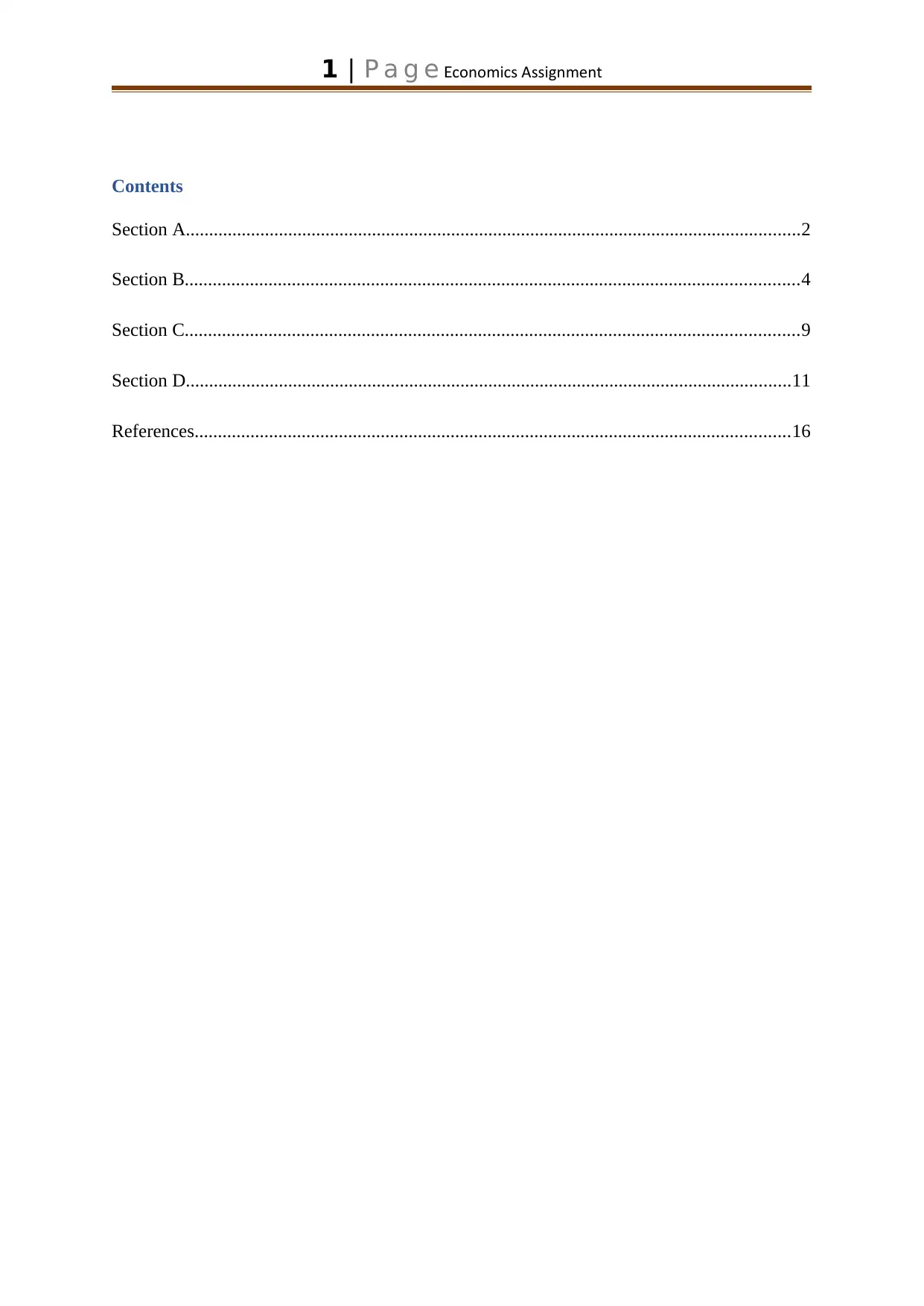
1 | P a g e conomics AssignmentE
Contents
Section A....................................................................................................................................2
Section B....................................................................................................................................4
Section C....................................................................................................................................9
Section D..................................................................................................................................11
References................................................................................................................................16
Contents
Section A....................................................................................................................................2
Section B....................................................................................................................................4
Section C....................................................................................................................................9
Section D..................................................................................................................................11
References................................................................................................................................16
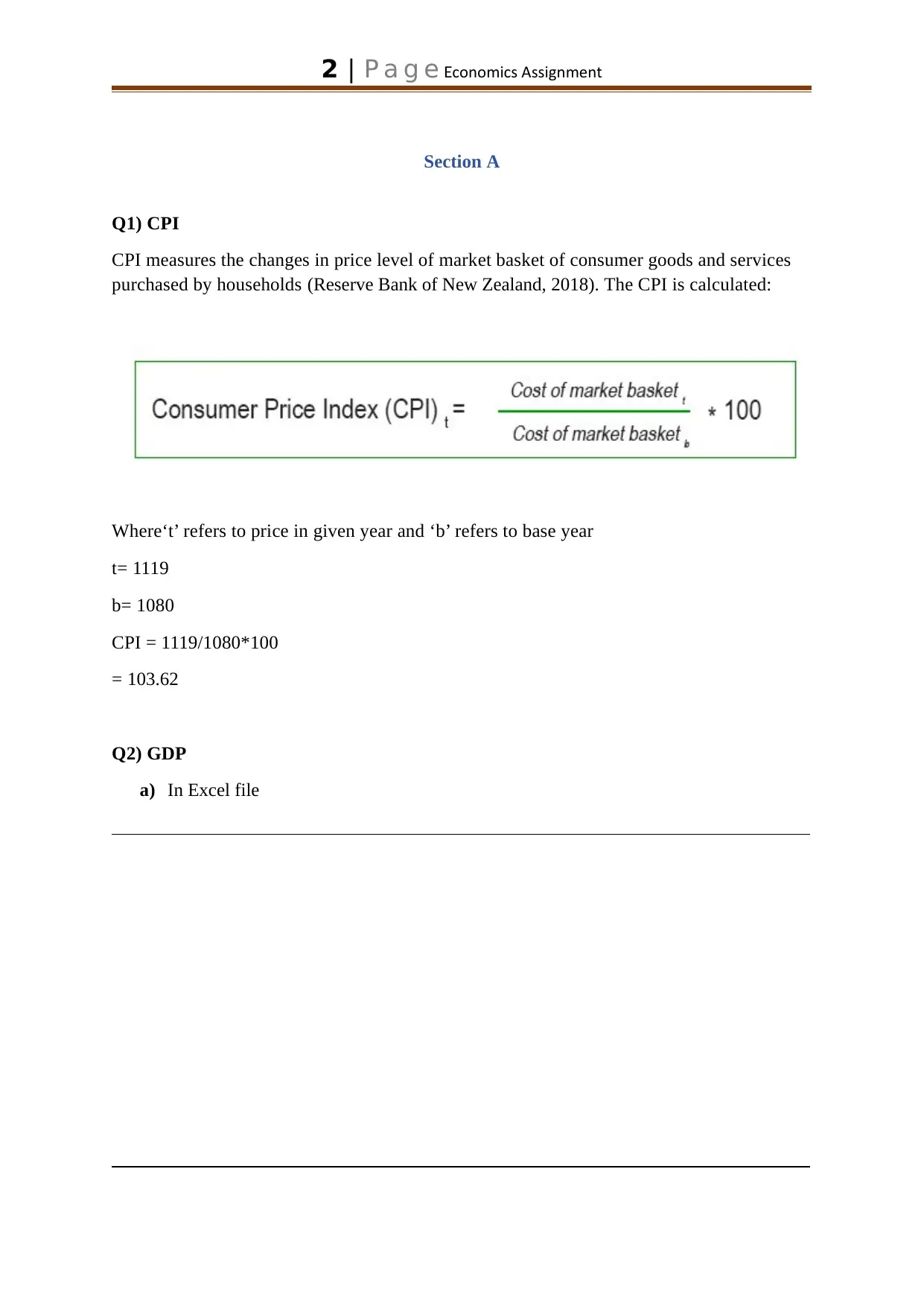
2 | P a g e conomics AssignmentE
Section A
Q1) CPI
CPI measures the changes in price level of market basket of consumer goods and services
purchased by households (Reserve Bank of New Zealand, 2018). The CPI is calculated:
Where‘t’ refers to price in given year and ‘b’ refers to base year
t= 1119
b= 1080
CPI = 1119/1080*100
= 103.62
Q2) GDP
a) In Excel file
Section A
Q1) CPI
CPI measures the changes in price level of market basket of consumer goods and services
purchased by households (Reserve Bank of New Zealand, 2018). The CPI is calculated:
Where‘t’ refers to price in given year and ‘b’ refers to base year
t= 1119
b= 1080
CPI = 1119/1080*100
= 103.62
Q2) GDP
a) In Excel file
⊘ This is a preview!⊘
Do you want full access?
Subscribe today to unlock all pages.

Trusted by 1+ million students worldwide
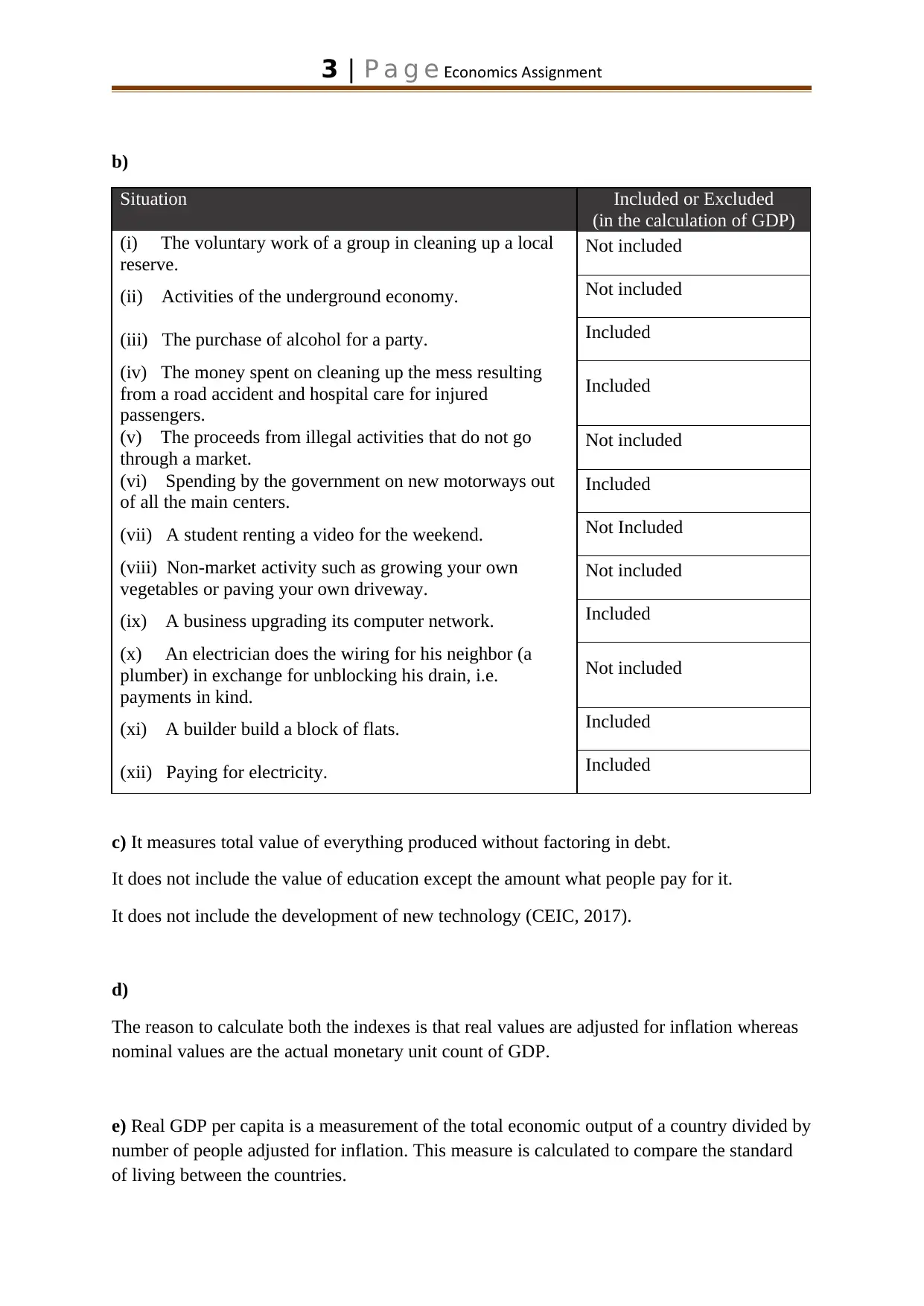
3 | P a g e conomics AssignmentE
b)
Situation Included or Excluded
(in the calculation of GDP)
(i) The voluntary work of a group in cleaning up a local
reserve. Not included
(ii) Activities of the underground economy. Not included
(iii) The purchase of alcohol for a party. Included
(iv) The money spent on cleaning up the mess resulting
from a road accident and hospital care for injured
passengers.
Included
(v) The proceeds from illegal activities that do not go
through a market. Not included
(vi) Spending by the government on new motorways out
of all the main centers. Included
(vii) A student renting a video for the weekend. Not Included
(viii) Non-market activity such as growing your own
vegetables or paving your own driveway. Not included
(ix) A business upgrading its computer network. Included
(x) An electrician does the wiring for his neighbor (a
plumber) in exchange for unblocking his drain, i.e.
payments in kind.
Not included
(xi) A builder build a block of flats. Included
(xii) Paying for electricity. Included
c) It measures total value of everything produced without factoring in debt.
It does not include the value of education except the amount what people pay for it.
It does not include the development of new technology (CEIC, 2017).
d)
The reason to calculate both the indexes is that real values are adjusted for inflation whereas
nominal values are the actual monetary unit count of GDP.
e) Real GDP per capita is a measurement of the total economic output of a country divided by
number of people adjusted for inflation. This measure is calculated to compare the standard
of living between the countries.
b)
Situation Included or Excluded
(in the calculation of GDP)
(i) The voluntary work of a group in cleaning up a local
reserve. Not included
(ii) Activities of the underground economy. Not included
(iii) The purchase of alcohol for a party. Included
(iv) The money spent on cleaning up the mess resulting
from a road accident and hospital care for injured
passengers.
Included
(v) The proceeds from illegal activities that do not go
through a market. Not included
(vi) Spending by the government on new motorways out
of all the main centers. Included
(vii) A student renting a video for the weekend. Not Included
(viii) Non-market activity such as growing your own
vegetables or paving your own driveway. Not included
(ix) A business upgrading its computer network. Included
(x) An electrician does the wiring for his neighbor (a
plumber) in exchange for unblocking his drain, i.e.
payments in kind.
Not included
(xi) A builder build a block of flats. Included
(xii) Paying for electricity. Included
c) It measures total value of everything produced without factoring in debt.
It does not include the value of education except the amount what people pay for it.
It does not include the development of new technology (CEIC, 2017).
d)
The reason to calculate both the indexes is that real values are adjusted for inflation whereas
nominal values are the actual monetary unit count of GDP.
e) Real GDP per capita is a measurement of the total economic output of a country divided by
number of people adjusted for inflation. This measure is calculated to compare the standard
of living between the countries.
Paraphrase This Document
Need a fresh take? Get an instant paraphrase of this document with our AI Paraphraser
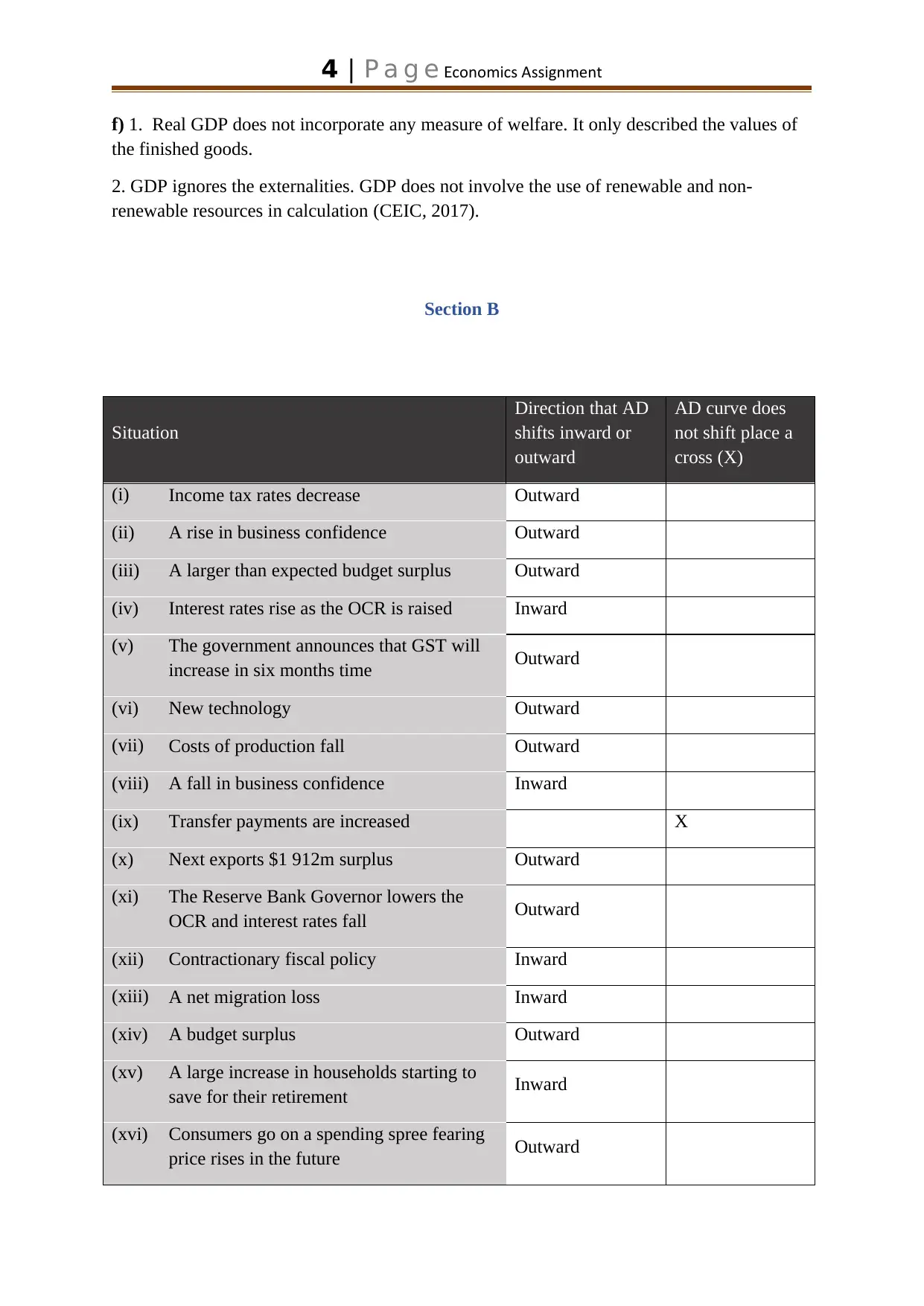
4 | P a g e conomics AssignmentE
f) 1. Real GDP does not incorporate any measure of welfare. It only described the values of
the finished goods.
2. GDP ignores the externalities. GDP does not involve the use of renewable and non-
renewable resources in calculation (CEIC, 2017).
Section B
Situation
Direction that AD
shifts inward or
outward
AD curve does
not shift place a
cross (X)
(i) Income tax rates decrease Outward
(ii) A rise in business confidence Outward
(iii) A larger than expected budget surplus Outward
(iv) Interest rates rise as the OCR is raised Inward
(v) The government announces that GST will
increase in six months time Outward
(vi) New technology Outward
(vii) Costs of production fall Outward
(viii) A fall in business confidence Inward
(ix) Transfer payments are increased X
(x) Next exports $1 912m surplus Outward
(xi) The Reserve Bank Governor lowers the
OCR and interest rates fall Outward
(xii) Contractionary fiscal policy Inward
(xiii) A net migration loss Inward
(xiv) A budget surplus Outward
(xv) A large increase in households starting to
save for their retirement Inward
(xvi) Consumers go on a spending spree fearing
price rises in the future Outward
f) 1. Real GDP does not incorporate any measure of welfare. It only described the values of
the finished goods.
2. GDP ignores the externalities. GDP does not involve the use of renewable and non-
renewable resources in calculation (CEIC, 2017).
Section B
Situation
Direction that AD
shifts inward or
outward
AD curve does
not shift place a
cross (X)
(i) Income tax rates decrease Outward
(ii) A rise in business confidence Outward
(iii) A larger than expected budget surplus Outward
(iv) Interest rates rise as the OCR is raised Inward
(v) The government announces that GST will
increase in six months time Outward
(vi) New technology Outward
(vii) Costs of production fall Outward
(viii) A fall in business confidence Inward
(ix) Transfer payments are increased X
(x) Next exports $1 912m surplus Outward
(xi) The Reserve Bank Governor lowers the
OCR and interest rates fall Outward
(xii) Contractionary fiscal policy Inward
(xiii) A net migration loss Inward
(xiv) A budget surplus Outward
(xv) A large increase in households starting to
save for their retirement Inward
(xvi) Consumers go on a spending spree fearing
price rises in the future Outward
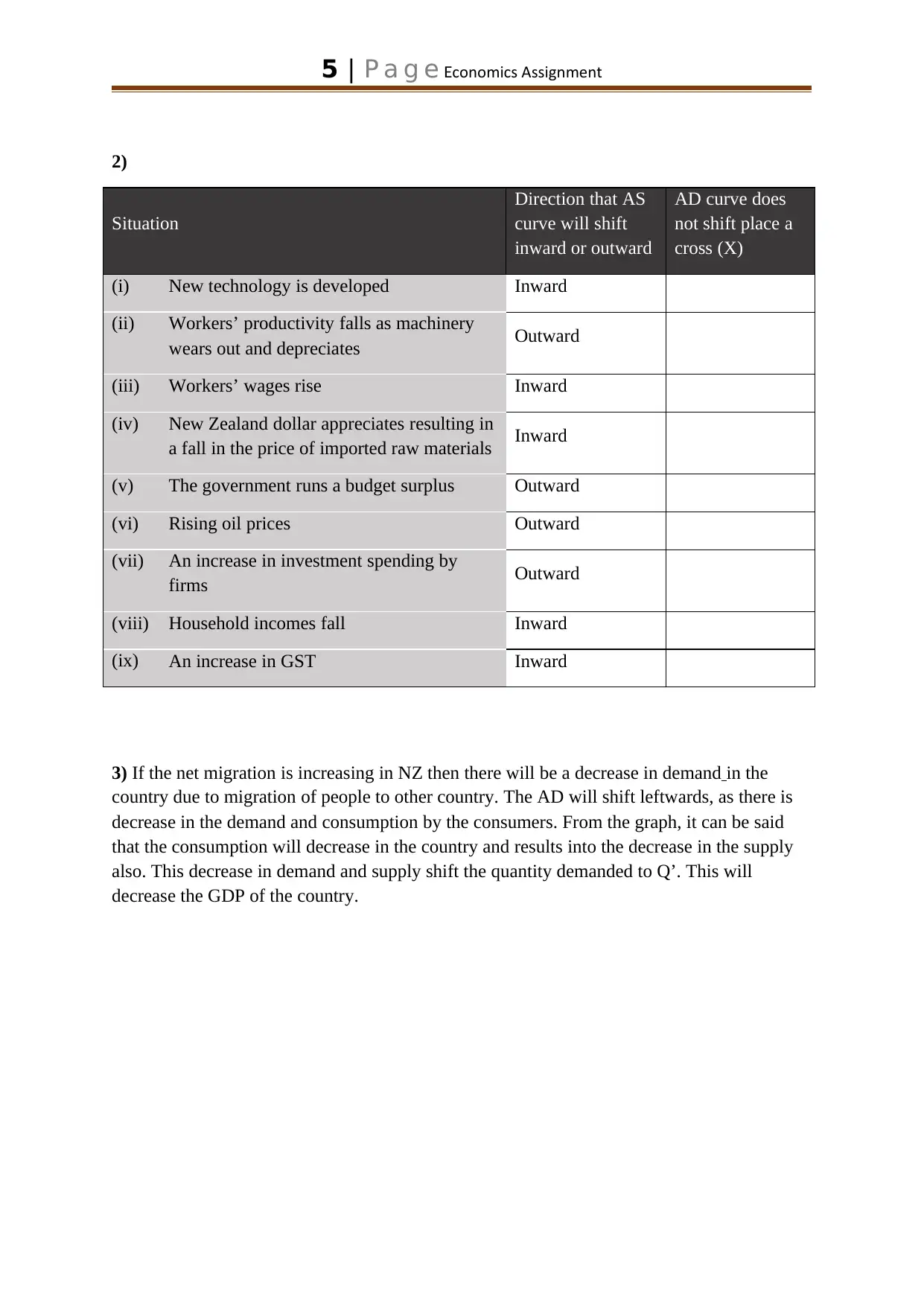
5 | P a g e conomics AssignmentE
2)
Situation
Direction that AS
curve will shift
inward or outward
AD curve does
not shift place a
cross (X)
(i) New technology is developed Inward
(ii) Workers’ productivity falls as machinery
wears out and depreciates Outward
(iii) Workers’ wages rise Inward
(iv) New Zealand dollar appreciates resulting in
a fall in the price of imported raw materials Inward
(v) The government runs a budget surplus Outward
(vi) Rising oil prices Outward
(vii) An increase in investment spending by
firms Outward
(viii) Household incomes fall Inward
(ix) An increase in GST Inward
3) If the net migration is increasing in NZ then there will be a decrease in demand in the
country due to migration of people to other country. The AD will shift leftwards, as there is
decrease in the demand and consumption by the consumers. From the graph, it can be said
that the consumption will decrease in the country and results into the decrease in the supply
also. This decrease in demand and supply shift the quantity demanded to Q’. This will
decrease the GDP of the country.
2)
Situation
Direction that AS
curve will shift
inward or outward
AD curve does
not shift place a
cross (X)
(i) New technology is developed Inward
(ii) Workers’ productivity falls as machinery
wears out and depreciates Outward
(iii) Workers’ wages rise Inward
(iv) New Zealand dollar appreciates resulting in
a fall in the price of imported raw materials Inward
(v) The government runs a budget surplus Outward
(vi) Rising oil prices Outward
(vii) An increase in investment spending by
firms Outward
(viii) Household incomes fall Inward
(ix) An increase in GST Inward
3) If the net migration is increasing in NZ then there will be a decrease in demand in the
country due to migration of people to other country. The AD will shift leftwards, as there is
decrease in the demand and consumption by the consumers. From the graph, it can be said
that the consumption will decrease in the country and results into the decrease in the supply
also. This decrease in demand and supply shift the quantity demanded to Q’. This will
decrease the GDP of the country.
⊘ This is a preview!⊘
Do you want full access?
Subscribe today to unlock all pages.

Trusted by 1+ million students worldwide
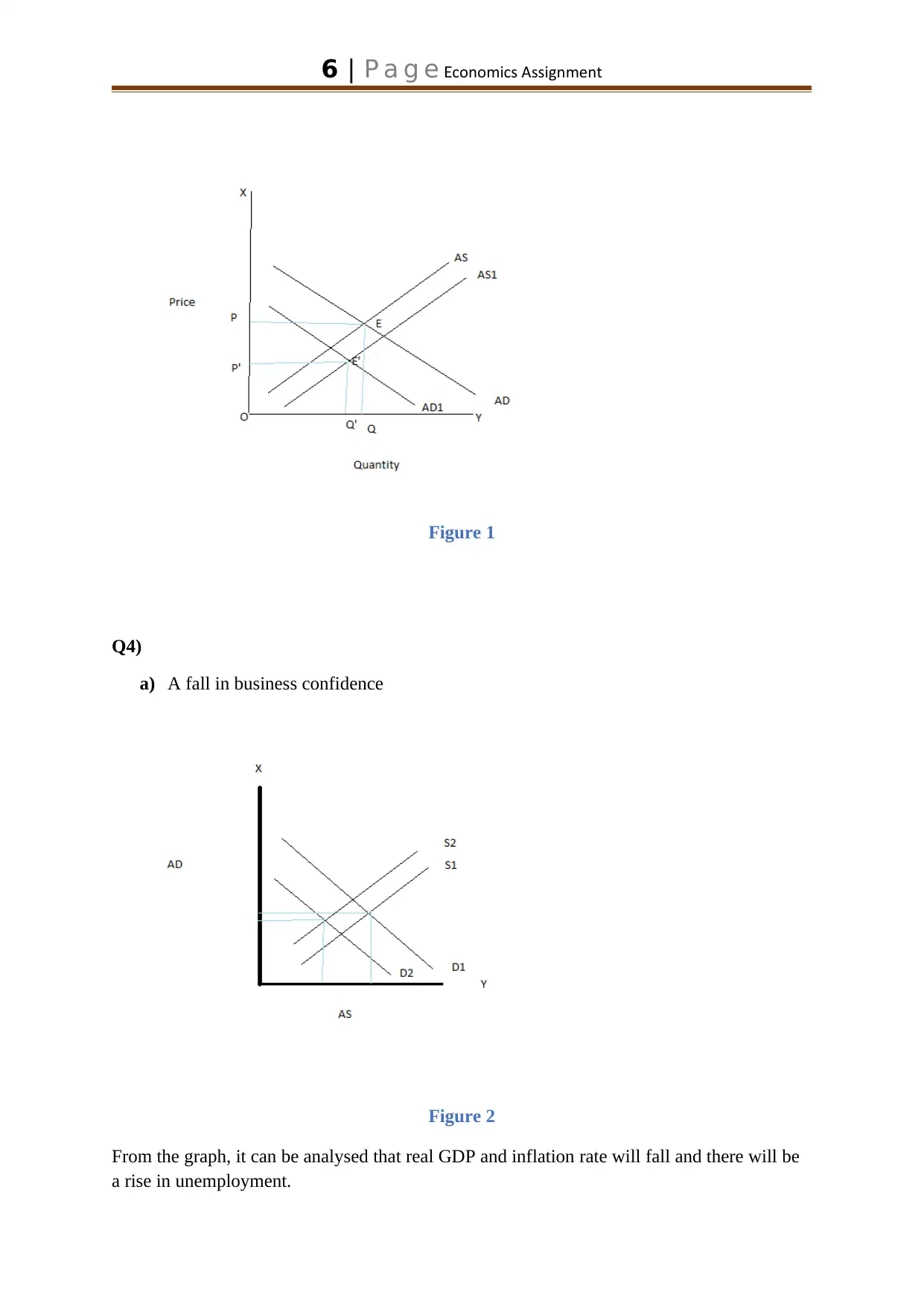
6 | P a g e conomics AssignmentE
Figure 1
Q4)
a) A fall in business confidence
Figure 2
From the graph, it can be analysed that real GDP and inflation rate will fall and there will be
a rise in unemployment.
Figure 1
Q4)
a) A fall in business confidence
Figure 2
From the graph, it can be analysed that real GDP and inflation rate will fall and there will be
a rise in unemployment.
Paraphrase This Document
Need a fresh take? Get an instant paraphrase of this document with our AI Paraphraser
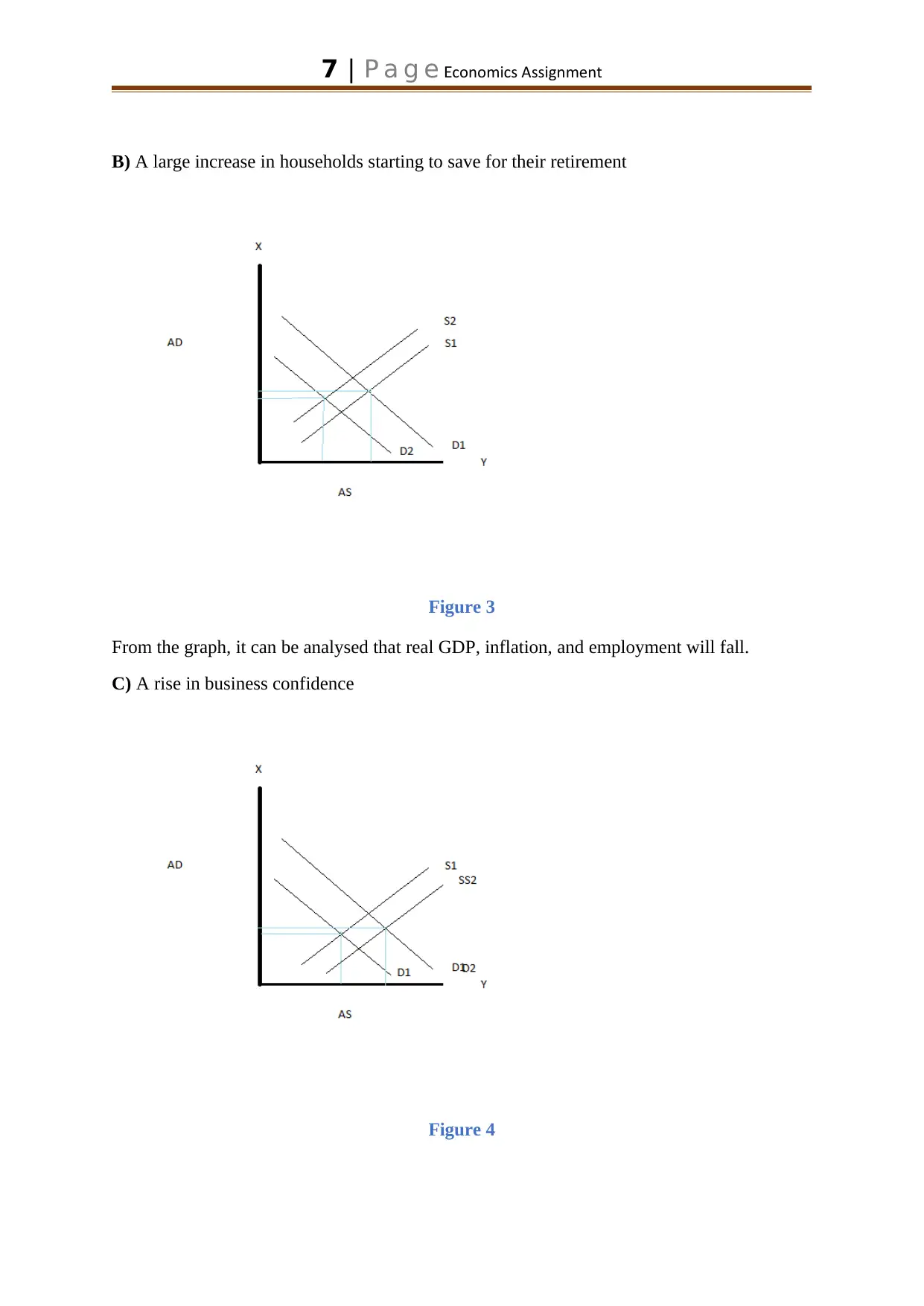
7 | P a g e conomics AssignmentE
B) A large increase in households starting to save for their retirement
Figure 3
From the graph, it can be analysed that real GDP, inflation, and employment will fall.
C) A rise in business confidence
Figure 4
B) A large increase in households starting to save for their retirement
Figure 3
From the graph, it can be analysed that real GDP, inflation, and employment will fall.
C) A rise in business confidence
Figure 4
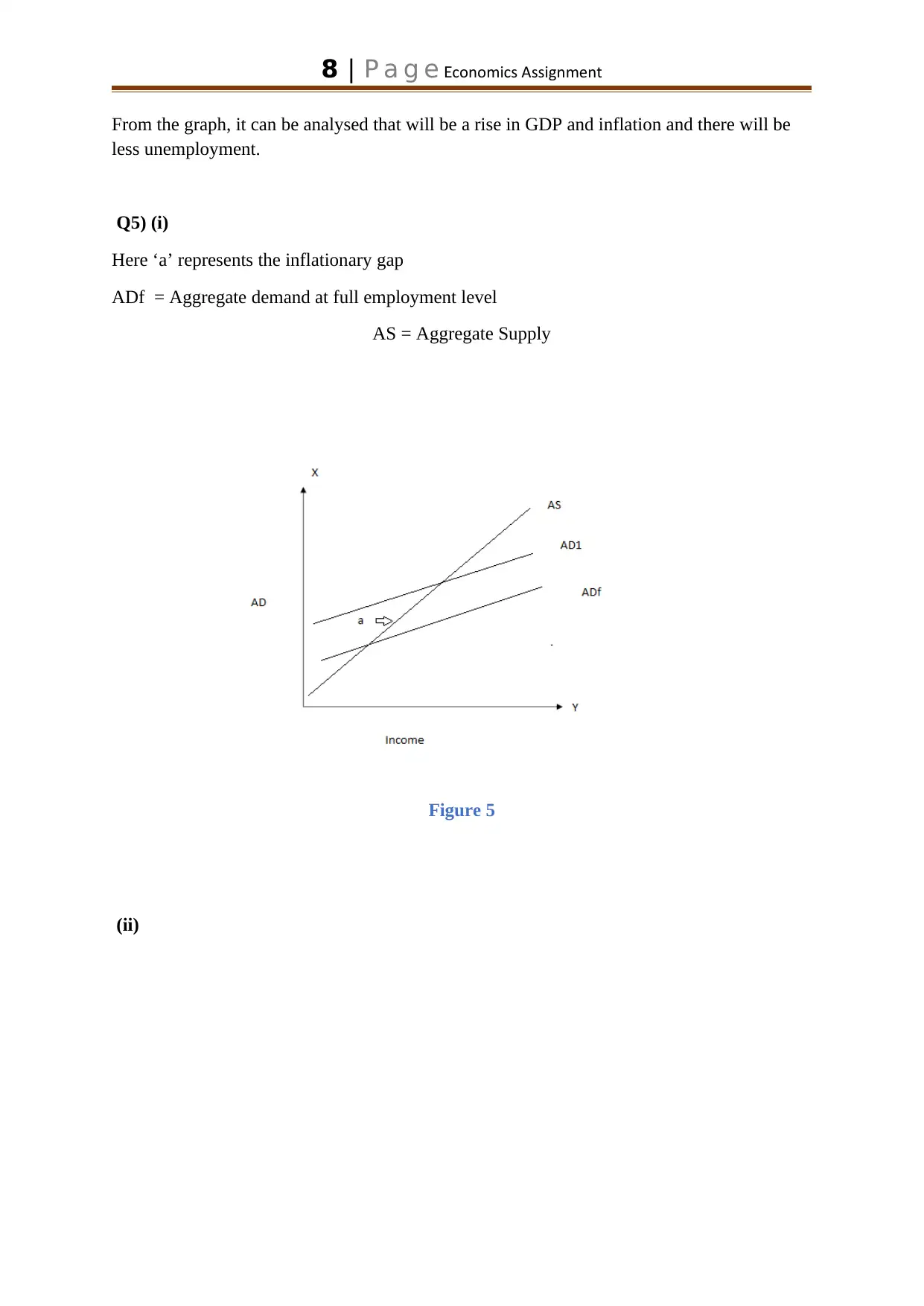
8 | P a g e conomics AssignmentE
From the graph, it can be analysed that will be a rise in GDP and inflation and there will be
less unemployment.
Q5) (i)
Here ‘a’ represents the inflationary gap
ADf = Aggregate demand at full employment level
AS = Aggregate Supply
Figure 5
(ii)
From the graph, it can be analysed that will be a rise in GDP and inflation and there will be
less unemployment.
Q5) (i)
Here ‘a’ represents the inflationary gap
ADf = Aggregate demand at full employment level
AS = Aggregate Supply
Figure 5
(ii)
⊘ This is a preview!⊘
Do you want full access?
Subscribe today to unlock all pages.

Trusted by 1+ million students worldwide
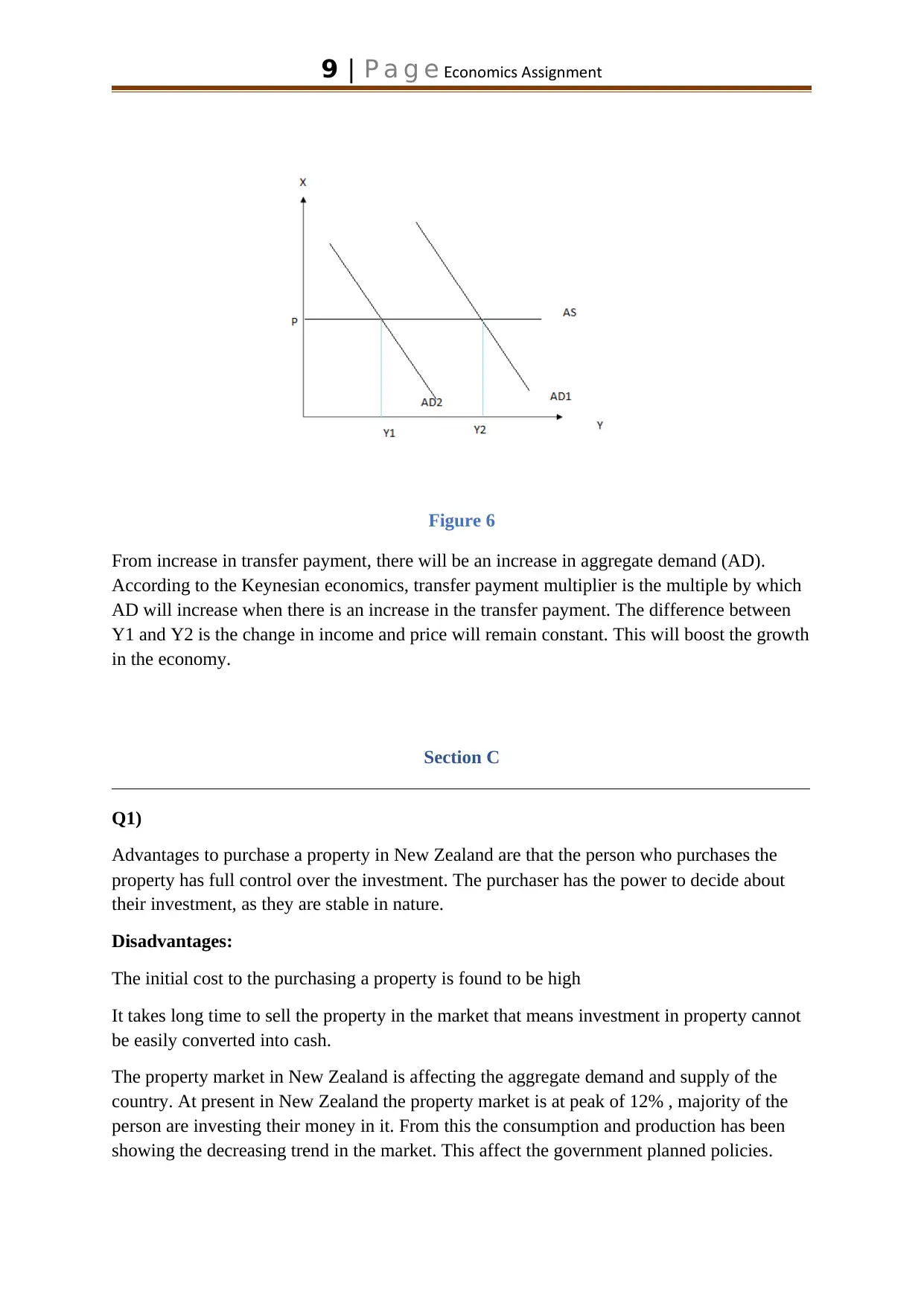
9 | P a g e conomics AssignmentE
Figure 6
From increase in transfer payment, there will be an increase in aggregate demand (AD).
According to the Keynesian economics, transfer payment multiplier is the multiple by which
AD will increase when there is an increase in the transfer payment. The difference between
Y1 and Y2 is the change in income and price will remain constant. This will boost the growth
in the economy.
Section C
Q1)
Advantages to purchase a property in New Zealand are that the person who purchases the
property has full control over the investment. The purchaser has the power to decide about
their investment, as they are stable in nature.
Disadvantages:
The initial cost to the purchasing a property is found to be high
It takes long time to sell the property in the market that means investment in property cannot
be easily converted into cash.
The property market in New Zealand is affecting the aggregate demand and supply of the
country. At present in New Zealand the property market is at peak of 12% , majority of the
person are investing their money in it. From this the consumption and production has been
showing the decreasing trend in the market. This affect the government planned policies.
Figure 6
From increase in transfer payment, there will be an increase in aggregate demand (AD).
According to the Keynesian economics, transfer payment multiplier is the multiple by which
AD will increase when there is an increase in the transfer payment. The difference between
Y1 and Y2 is the change in income and price will remain constant. This will boost the growth
in the economy.
Section C
Q1)
Advantages to purchase a property in New Zealand are that the person who purchases the
property has full control over the investment. The purchaser has the power to decide about
their investment, as they are stable in nature.
Disadvantages:
The initial cost to the purchasing a property is found to be high
It takes long time to sell the property in the market that means investment in property cannot
be easily converted into cash.
The property market in New Zealand is affecting the aggregate demand and supply of the
country. At present in New Zealand the property market is at peak of 12% , majority of the
person are investing their money in it. From this the consumption and production has been
showing the decreasing trend in the market. This affect the government planned policies.
Paraphrase This Document
Need a fresh take? Get an instant paraphrase of this document with our AI Paraphraser
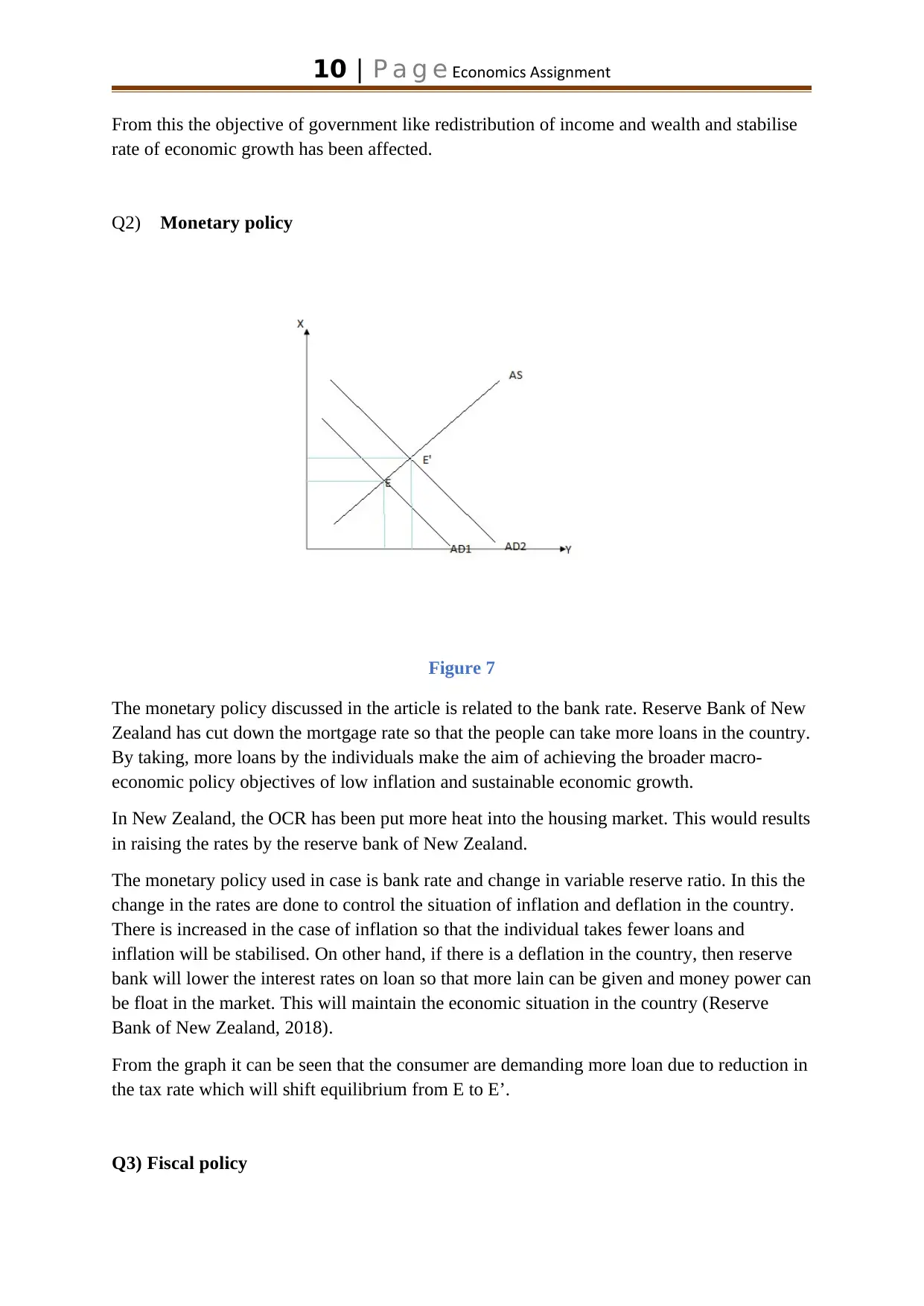
10 | P a g e conomics AssignmentE
From this the objective of government like redistribution of income and wealth and stabilise
rate of economic growth has been affected.
Q2) Monetary policy
Figure 7
The monetary policy discussed in the article is related to the bank rate. Reserve Bank of New
Zealand has cut down the mortgage rate so that the people can take more loans in the country.
By taking, more loans by the individuals make the aim of achieving the broader macro-
economic policy objectives of low inflation and sustainable economic growth.
In New Zealand, the OCR has been put more heat into the housing market. This would results
in raising the rates by the reserve bank of New Zealand.
The monetary policy used in case is bank rate and change in variable reserve ratio. In this the
change in the rates are done to control the situation of inflation and deflation in the country.
There is increased in the case of inflation so that the individual takes fewer loans and
inflation will be stabilised. On other hand, if there is a deflation in the country, then reserve
bank will lower the interest rates on loan so that more lain can be given and money power can
be float in the market. This will maintain the economic situation in the country (Reserve
Bank of New Zealand, 2018).
From the graph it can be seen that the consumer are demanding more loan due to reduction in
the tax rate which will shift equilibrium from E to E’.
Q3) Fiscal policy
From this the objective of government like redistribution of income and wealth and stabilise
rate of economic growth has been affected.
Q2) Monetary policy
Figure 7
The monetary policy discussed in the article is related to the bank rate. Reserve Bank of New
Zealand has cut down the mortgage rate so that the people can take more loans in the country.
By taking, more loans by the individuals make the aim of achieving the broader macro-
economic policy objectives of low inflation and sustainable economic growth.
In New Zealand, the OCR has been put more heat into the housing market. This would results
in raising the rates by the reserve bank of New Zealand.
The monetary policy used in case is bank rate and change in variable reserve ratio. In this the
change in the rates are done to control the situation of inflation and deflation in the country.
There is increased in the case of inflation so that the individual takes fewer loans and
inflation will be stabilised. On other hand, if there is a deflation in the country, then reserve
bank will lower the interest rates on loan so that more lain can be given and money power can
be float in the market. This will maintain the economic situation in the country (Reserve
Bank of New Zealand, 2018).
From the graph it can be seen that the consumer are demanding more loan due to reduction in
the tax rate which will shift equilibrium from E to E’.
Q3) Fiscal policy
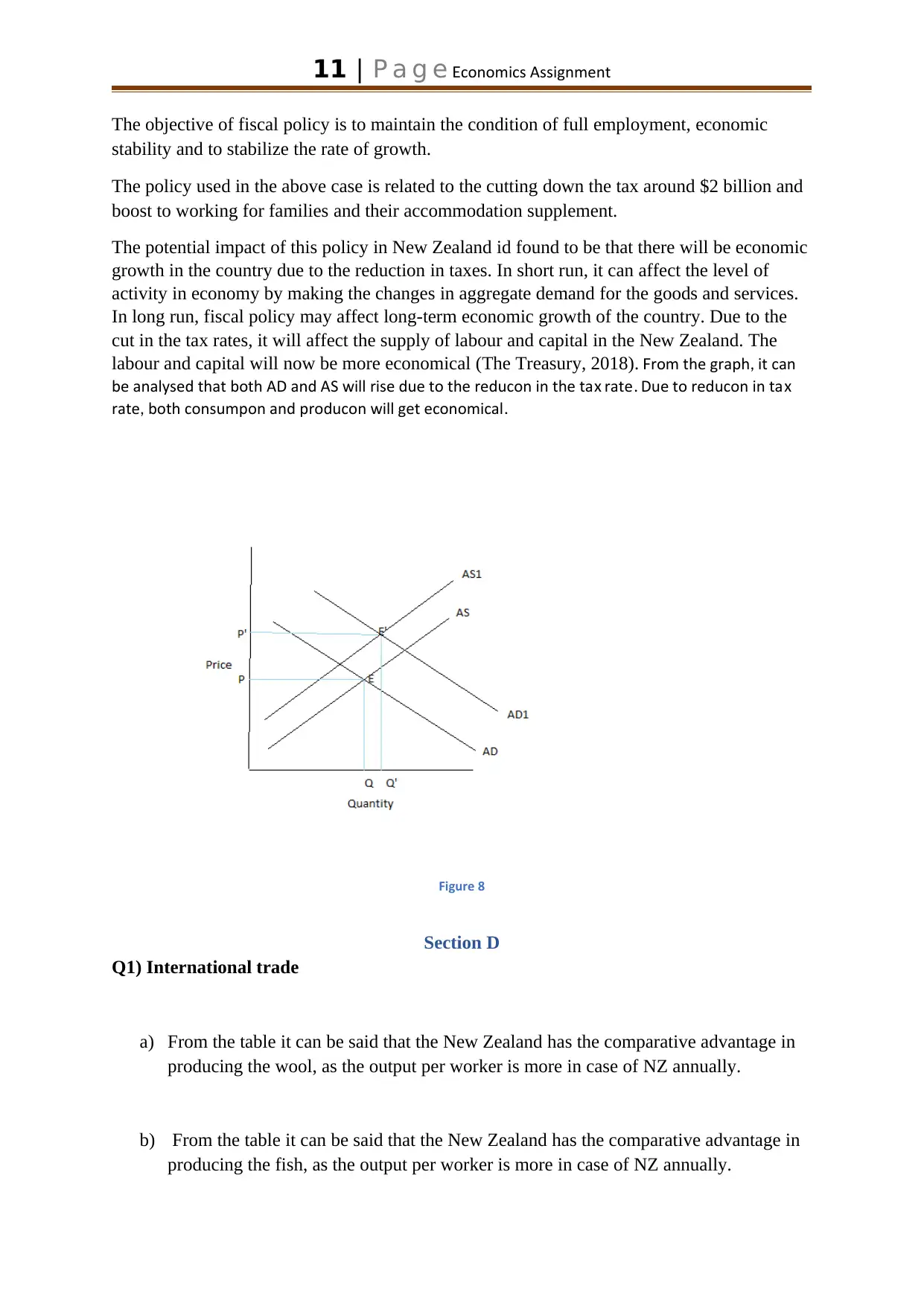
11 | P a g e conomics AssignmentE
The objective of fiscal policy is to maintain the condition of full employment, economic
stability and to stabilize the rate of growth.
The policy used in the above case is related to the cutting down the tax around $2 billion and
boost to working for families and their accommodation supplement.
The potential impact of this policy in New Zealand id found to be that there will be economic
growth in the country due to the reduction in taxes. In short run, it can affect the level of
activity in economy by making the changes in aggregate demand for the goods and services.
In long run, fiscal policy may affect long-term economic growth of the country. Due to the
cut in the tax rates, it will affect the supply of labour and capital in the New Zealand. The
labour and capital will now be more economical (The Treasury, 2018). rom the graph it canF ,
be analysed that both AD and AS will rise due to the reduction in the ta rate Due to reduction in tax . x
rate both consumption and production will get economical, .
Figure 8
Section D
Q1) International trade
a) From the table it can be said that the New Zealand has the comparative advantage in
producing the wool, as the output per worker is more in case of NZ annually.
b) From the table it can be said that the New Zealand has the comparative advantage in
producing the fish, as the output per worker is more in case of NZ annually.
The objective of fiscal policy is to maintain the condition of full employment, economic
stability and to stabilize the rate of growth.
The policy used in the above case is related to the cutting down the tax around $2 billion and
boost to working for families and their accommodation supplement.
The potential impact of this policy in New Zealand id found to be that there will be economic
growth in the country due to the reduction in taxes. In short run, it can affect the level of
activity in economy by making the changes in aggregate demand for the goods and services.
In long run, fiscal policy may affect long-term economic growth of the country. Due to the
cut in the tax rates, it will affect the supply of labour and capital in the New Zealand. The
labour and capital will now be more economical (The Treasury, 2018). rom the graph it canF ,
be analysed that both AD and AS will rise due to the reduction in the ta rate Due to reduction in tax . x
rate both consumption and production will get economical, .
Figure 8
Section D
Q1) International trade
a) From the table it can be said that the New Zealand has the comparative advantage in
producing the wool, as the output per worker is more in case of NZ annually.
b) From the table it can be said that the New Zealand has the comparative advantage in
producing the fish, as the output per worker is more in case of NZ annually.
⊘ This is a preview!⊘
Do you want full access?
Subscribe today to unlock all pages.

Trusted by 1+ million students worldwide
1 out of 18
Related Documents
Your All-in-One AI-Powered Toolkit for Academic Success.
+13062052269
info@desklib.com
Available 24*7 on WhatsApp / Email
![[object Object]](/_next/static/media/star-bottom.7253800d.svg)
Unlock your academic potential
Copyright © 2020–2025 A2Z Services. All Rights Reserved. Developed and managed by ZUCOL.

